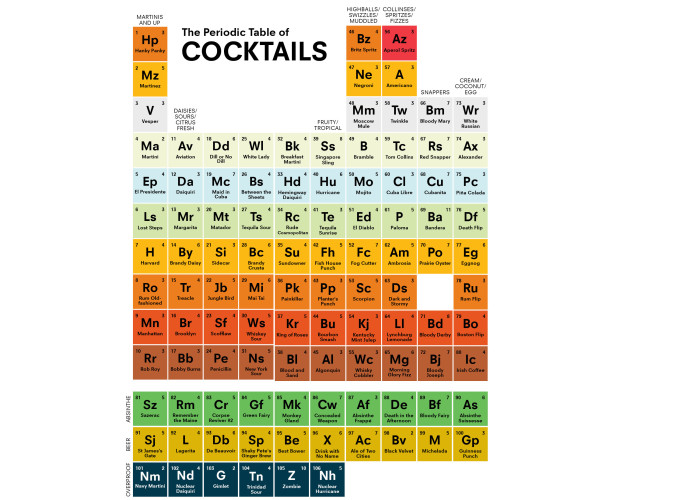Check Out This Periodic Table Of Cocktails Infographic
Welcome to The Periodic Table of Cocktails (click image for larger view). The idea behind this book is to organize more than 100 cocktails into a map of sorts, allowing you to explore the various types and categories of cocktails in terms of their similarities, but also their points of difference.
I've included classic cocktails steeped in history alongside modern classics that feature on menus in bars the world over, as well as a few ultra-modern creations that you may not have heard of yet, but soon will.
The cocktail category is huge. There are so many spirits, liqueurs, juices and other ingredients that the possibilities are endless. With thousands of such possibilities, it can be daunting to know where to begin with a cocktail menu. What I hope is that, by using the table, people will be able to start with cocktails they know and love, and then move around the table to discover new drinks, with the flavors evolving as they go — yet still maintaining similar features to the previous drink.
Graphic and excerpt reprinted with permission from The Periodic Table of Cocktails by Emma Stokes, published by Abrams © 2017.
How It Works
Each element in the table is a distinctive cocktail. They are grouped into styles of cocktails in columns and by predominant base alcohol across the rows (the "periods"). The cocktails get longer (greater in volume) as you progress from left to right across the table, from the first column of martinis all the way to the collinses, fizzes and snappers on the far right. In the rows, the spirits or liqueurs become "heavier" as you move down the table. You'll therefore find vodka- and gin-based cocktails at the top, and bourbon- and whiskey-based cocktails toward the bottom.
The aim of all of this is that if you like one cocktail in the table, you should like all the cocktails the surround it, as they will be of similar style and/or use a similar or the same base spirit. Next time you're glancing at a cocktail menu or working out what to concoct at home, you'll hopefully have the confidence to try something new and the knowledge to choose a little more wisely.
The three categories at the bottom of the table, termed the "rare earth" elements on the original periodic table and separated from the main table, contain the more unusual types and styles of cocktails. They follow the same principles as the columns in the main table, so they get longer as you move from left to right, but rather than a predominant base spirit, they have other traits in common: the use of absinthe, beer or overproof spirits.
Cheers!


